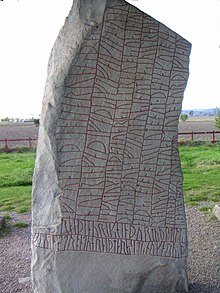Runic Swedish
Runic Swedish is the oldest known written version of Swedish, used from c.800 to 1225. The end of the period is marked by the Västgötalagen text, the oldest Swedish text written using the Latin alphabet. This writing is called "Runic Swedish" because it was written using runes. The name is in fact a misnomer however, because there are few differences between this language and the language known is Denmark as runic Danish. Therefore, the term Old East Norse is preferred. This language was in turn particularly similar to the so called Old West Norse, which is why the two are usually seen as dialects of one language, Old Norse. During the early Viking Age, these groups were indistinguishable. The differences increased later, but not so large that they were seen as different languages until the late Middle Ages.
Proto-Norse to Runic Swedish
4000 years ago, large portions of Europe and parts of Asia spoke a daughter language to the Proto-Indo-European language, which later developed into several different languages, including North Germanic. This early form had a completely different pronunciation and a different vowel system that its modern descendants.
It is not well known what the Proto-Norse language looked like. Some clues can be gathered from Proto-Norse loanwords in Finnish and Sami. Some of these still exist, for example Finnish's kuningas (king), from Proto-Norse's kuningaz. Runic Swedish is more similar to today's Swedish than to Proto-Norse, and some word are pronounced almost the same as today.
Proto-Nordic was likely replaced by runic Swedish around the year 800, when the older runic script of 24 symbols was replaced by a newer one with just 16 symbols. This is also when the new sounds "y", "å", and "ö" appeared. About 3000 texts written in runic Swedish have been discovered to date.
Runic Swedish also has loanwords from the time when the vikings traveled through Europe, and from the priests that during this time were trying to Christianize Sweden.
Runes
Even if the Latin script had not come to the Nordic countries until after the end of the Viking Age, the people there could already write. They then wrote with the Germanic symbols called runes. The oldest runes found were carved over 2000 years ago. Standing stones with rune inscriptions exist only in the Nordic countries.[1] There were two different types of runes in runic Swedish, normal runes and rökrunor. The only difference is their appearance - they can be considered two different styles of handwriting. Almost all existing rune carvings are carved in stone, although it may have been more common to cut runes in wood. Because wood rots easily, almost no wood runes survive today. The word "runa" means "secret". Not everyone switched to the Latin alphabet at the end of the runic period however. Paper was expensive, so peasants continued to carve messages in runes on pieces of wood for a long time.
Grammar

- Main Article: Runic Swedish Grammar
Nouns in runic Swedish are declined to match gender.
Examples
The poem of Theoderic the Great on the Rök Runestone from ca. 800:
Original text:
- raiþ þiaurikR hin þurmuþi stiliR flutna strãntu hraiþmaraR
- sitiR nu karuR ã kuta sinum skialti ub fatlaþR skati marika
Transcription:
- Reið Þjóðrikr hinn þurmoði, stillir flutna, strandu Hraiðmarar.
- Sitir nu garur, á guta sinum, skjaldi umb fatlaðr, skati Mæringa.
Modern Icelandic:
- Reið Þjóðrekur, hinn þormoði, stillir flotna, ströndu Hreiðmarar.
- Sitir nu görr, á gota sinum, skjaldi of fatlaður, skati Mæringa.
Translation:
Then Theoderik reigned, the bold, King of the Sea Warriors, over the coast of the Hreidhav.
He now sits armed, on his Gotlandic horse, shield over his shoulder, first among the Märing people.
ÞiaurikR is usually translated as Theoderic the Great of the kingdom of the Ostrogoths.
See also
References
Notes
- ^ Gertrud Pettersson, Svenska språket under sjuhundra år, s. 53
Sources
- Gertrud Pettersson, Svenska språket under sjuhundra år, Lund 2005.
